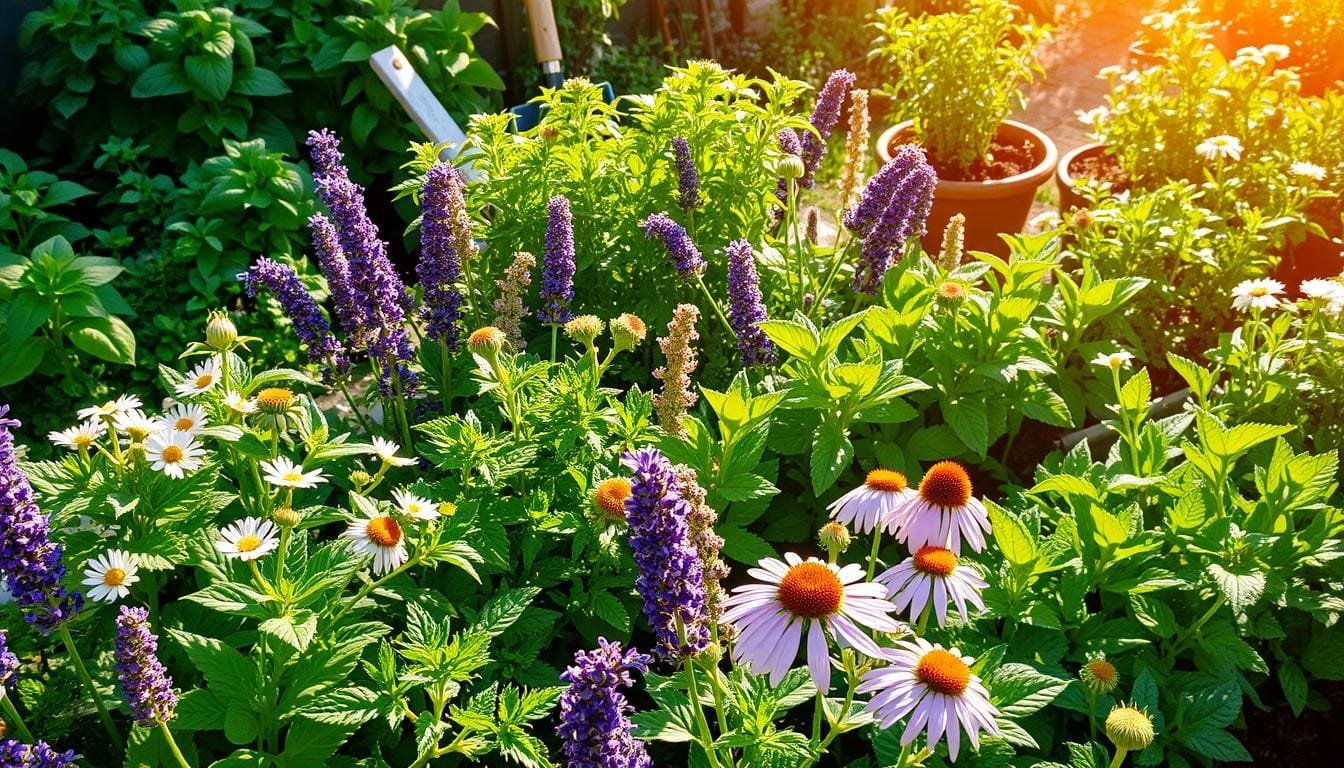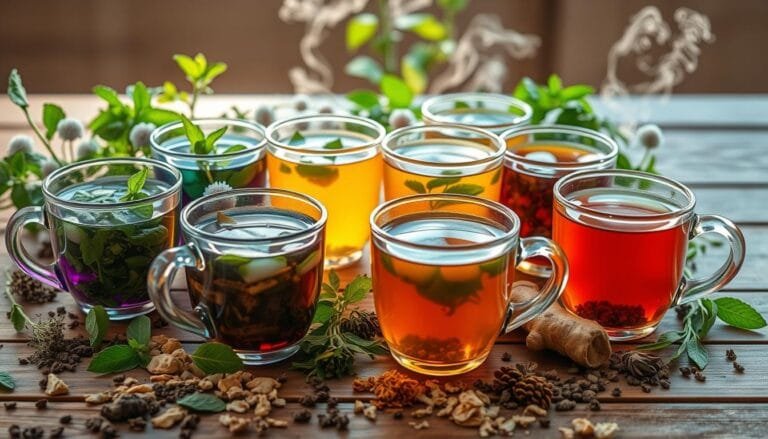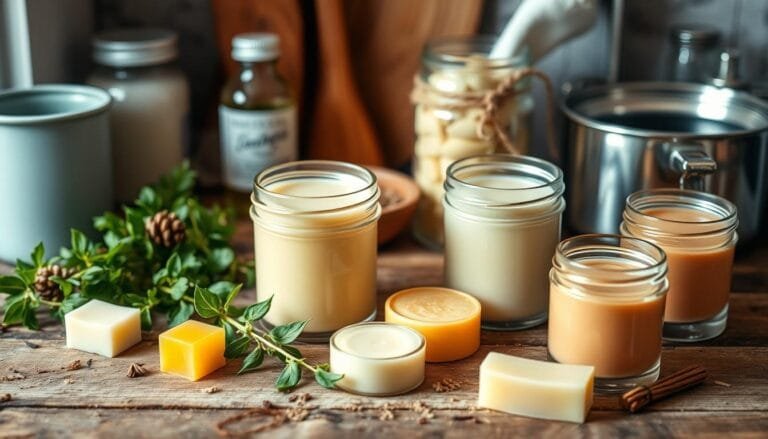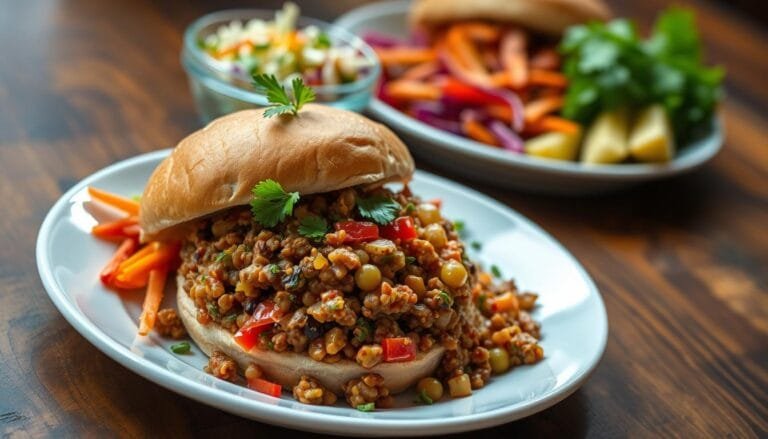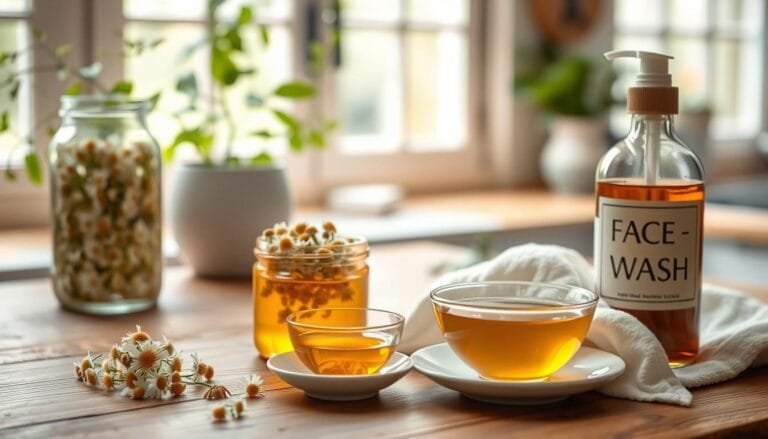I love gardening and have found the joy of growing medicinal herbs. These plants make my garden look beautiful and give me a natural way to heal. They help with skin problems and boost our immune system.
Some of the best herbs to grow include calendula, chamomile, and lavender. Holy basil, echinacea, and lemon balm are also great. Bergamot, borage, hyssop, and white sage round out the list. Each herb offers unique benefits for our health, from skin care to breathing easier.
Growing these herbs has brought peace and focus to my life. It’s a calming experience to care for and harvest them. I think everyone should try growing their own medicinal herbs. It’s a way to connect with nature and find healing in our gardens.
Understanding the Benefits of Growing Your Own Healing Garden
Growing a garden with organic herbs brings many benefits. It lets us control the quality and sustainability of our plants. This way, we avoid harmful chemicals and help protect endangered species.
By growing our own organic herbs, we get homegrown remedies that save money. These sustainable gardening practices also help us feel less stressed and anxious.
Control Over Quality and Sustainability
Growing our own herbs means we decide how they’re grown. This means they’re free from harmful chemicals. We also help protect endangered species by not over-harvesting them.
Cost-Effective Natural Healthcare
Using homegrown herbs can cut down on healthcare costs. Dried herbs last about a year, and store-bought ones are often older. Growing our own organic herbs saves money and gives us the freshest herbs.
Therapeutic Benefits of Garden Maintenance
Gardening itself has many health benefits. It can lower stress hormones and help us relax. Gardening also helps us connect with others, building community and a sense of belonging.
Creating a healing garden is more than just growing medicinal herbs. It’s a way to improve our health and well-being, combining physical, mental, and social benefits.
Essential Planning Tips for Your Medicinal Herb Garden
Starting a medicinal herb garden is a rewarding journey. It’s great for finding natural remedies or enjoying the calm of gardening. To make your garden thrive, follow these key tips.
First, check your garden space and gardening zone. This will help you pick the right herbs and arrange them well. If you have little space, try container gardening. Also, knowing your local climate helps pick herbs that grow well there.
- Choose herbs that fit your family’s health needs and what you want to make. Lavender, calendula, chamomile, yarrow, feverfew, and echinacea are popular.
- Learn about the growth habits of your herbs. This tells you if they’ll grow year-round or need replanting.
- Think about how much space your herbs need and how they spread. Good spacing helps them grow well and prevents them from getting too crowded.
- Plan how you’ll harvest your herbs, like roots or leaves. Make sure you have the right tools and know-how to get your harvest.
Getting into herb garden planning and garden layout will lead to a rich harvest. With some planning and lots of love, your medicinal herb garden will flourish for years.
“The true medicine chest of the future will be the back garden and what can be grown in it.”
Calendula: The Versatile Skin-Healing Wonder
Calendula, also known as Calendula officinalis, is a favorite in natural medicine. This bright flower is known for healing the skin. It’s a key herb in many natural remedies.
Growing Requirements for Calendula
Calendula is easy to grow and loves full sun and regular soil. Plant them 10-14 inches apart. They can grow up to 18 inches tall. They bloom for months, showing off their bright orange flowers.
Harvesting and Processing Methods
Harvest calendula flowers every 2-3 days for a steady supply. The dried whole flowers are best for medicine. They contain oils that help heal. You can make teas, tinctures, oils, salves, and more with calendula.
Medicinal Applications
Calendula is more than just pretty. It heals the skin from bites, rashes, dandruff, and burns. Drinking it as tea helps the digestive system. It also boosts the immune system and fights off infections.
Calendula is loved for its gentle healing power. It’s great for skin issues and boosting health. Adding it to your garden is a smart move for natural remedies.

Echinacea: Building Natural Immunity
Echinacea is a powerful herb that supports our immune system. It’s easy to grow and can handle drought well. Native Americans have used it for over 400 years to fight infections and heal wounds.
Germany has led research on echinacea for decades. This shows its global importance.
Echinacea’s strength comes from its many phytochemicals. It has caffeic acid, alkamides, and more. These compounds help our immune system. It also has antioxidants like flavonoids that protect our cells.
Studies show echinacea can cut the risk of colds by 22%. It may also lower blood sugar and reduce anxiety. Its anti-inflammatory properties help with acne, wrinkles, and eczema.
Growing echinacea is simple. Plant seeds in full sun, 1-2 feet apart. They grow 3-4 feet tall. Harvest the roots after 2-3 years for the best benefits. You can make tea, tincture, or take supplements.
Echinacea is essential for a medicinal garden. It’s been trusted for centuries. Its benefits and ease of use make it a top choice for natural immunity.
| Echinacea Benefits | Echinacea Medicinal Uses |
|---|---|
|
|
“Echinacea has been used by Native Americans for over 400 years to treat infections and wounds, as well as a general ‘cure-all.'”
Echinacea is usually safe, but talk to a doctor first. This is true if you have health issues or take certain meds. With care, you can use echinacea to boost your immune system.
Holy Basil (Tulsi): Ancient Adaptogenic Power
Holy basil, also known as tulsi, comes from India and has been used for centuries. It’s an adaptogenic herb that helps the body deal with stress. This makes it a great choice for any garden focused on health.
Cultivation Techniques
Tulsi grows as an annual in cooler places but as a perennial in warmer areas. It loves full sun and well-drained soil. Start seeds indoors in late winter or early spring, then move them outside after the frost is gone.
When planting, cover the tiny black seeds lightly and let them get some sunlight. You can also grow tulsi in containers, perfect for small spaces.
Traditional Uses and Benefits
Tulsi has been valued in Ayurvedic medicine for its health benefits. It’s an adaptogenic herb that helps the body handle stress. Studies show it can lower blood sugar, improve cholesterol, and reduce inflammation.
It’s also good for stress, anxiety, and feeling tired. A study on young adults showed tulsi improved their energy, immune system, and heart health. The compound eugenol is key to its benefits.
While tulsi is safe for most, talk to a doctor if you’re pregnant, breastfeeding, a child, or an older adult. Always discuss the right amount and any possible drug interactions.
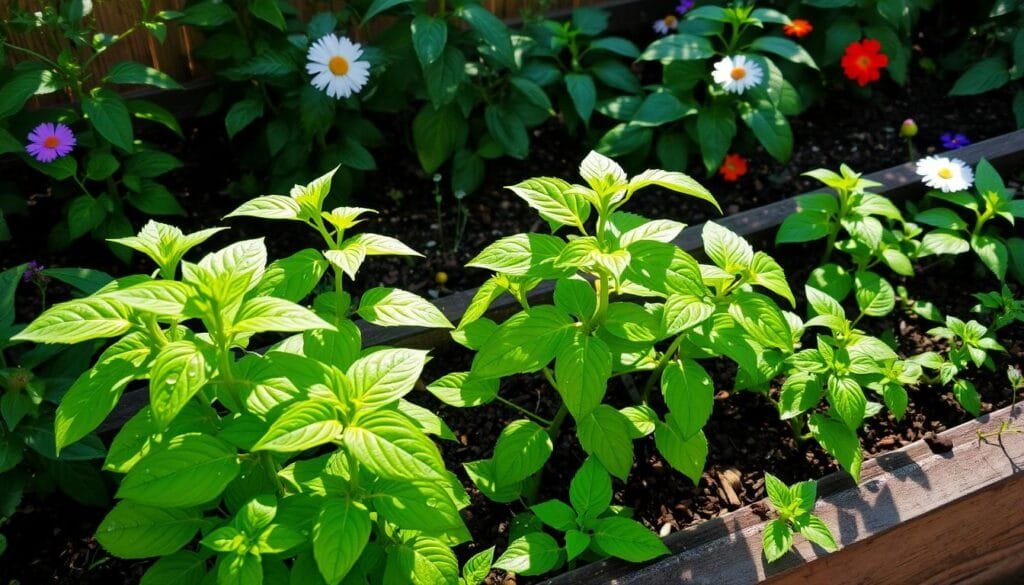
“Tulsi has been found to protect organs and tissues against chemical stress from industrial pollutants and heavy metals, as well as physical stress from physical exertion, ischemia, and exposure to cold and noise.”
Growing and using holy basil offers many health benefits. As an adaptogenic herb, it’s a valuable addition to any garden. It helps the body handle the stresses of today’s world naturally.
Medicinal Herbs to Grow for Digestive Health
Keeping your digestive system healthy is key to feeling good. Growing your own medicinal herbs is a great natural way to do this. Many herbs can help with stomach issues, reduce bloating, and keep your gut balanced. Let’s look at some top digestive herbs you can grow in your garden.
Peppermint is great for upset stomachs and motion sickness. Its cool and calming effects make it perfect for tea or tinctures. Chamomile is gentle and helps with nausea and menstrual cramps. It’s a great herb to have in your garden.
Fennel is amazing for reducing bloating and gas. Its flavor is like licorice and makes teas and remedies tasty. Ginger is a strong herb for fighting nausea and indigestion.
“Cultivating a garden filled with digestive herbs is a proactive step towards maintaining a healthy gut and overall well-being.” – Jane Doe, Holistic Wellness Advocate
These herbs are easy to grow in most gardens. You can use them fresh or dried to make soothing teas, tinctures, and remedies. Adding them to your daily routine can help you control your digestive health. Enjoy the benefits of these digestive herbs, stomach remedies, and herbal teas.
Starting small and experimenting with different herbs is important for a thriving medicinal garden. With patience and care, you can create a space filled with digestive herbs, stomach remedies, and herbal teas. This will nourish your body and soul.
Lemon Balm: Nature’s Calming Agent
Lemon balm is a member of the mint family. It’s known for its calming and therapeutic effects. This herb has been used for centuries to soothe the mind and promote relaxation.
Growing Conditions and Care
Lemon balm grows well in partial shade to full sun. It likes well-drained, nutrient-rich soil. If not contained, it can spread aggressively.
To keep lemon balm healthy, prune it regularly. Also, divide the roots to control its growth.
Therapeutic Properties
Lemon balm has been used for calming and soothing effects. It helps with stress, anxiety, sleep issues, indigestion, cold sores, and herpes. Its active compounds have anxiolytic, anti-depressant, and cognitive-enhancing properties.
You can use lemon balm in teas, tinctures, extracts, and as a dietary supplement. It’s also used topically for skin issues and wound healing. Always follow the recommended dosage and consult a healthcare professional, including pregnant or breastfeeding women.
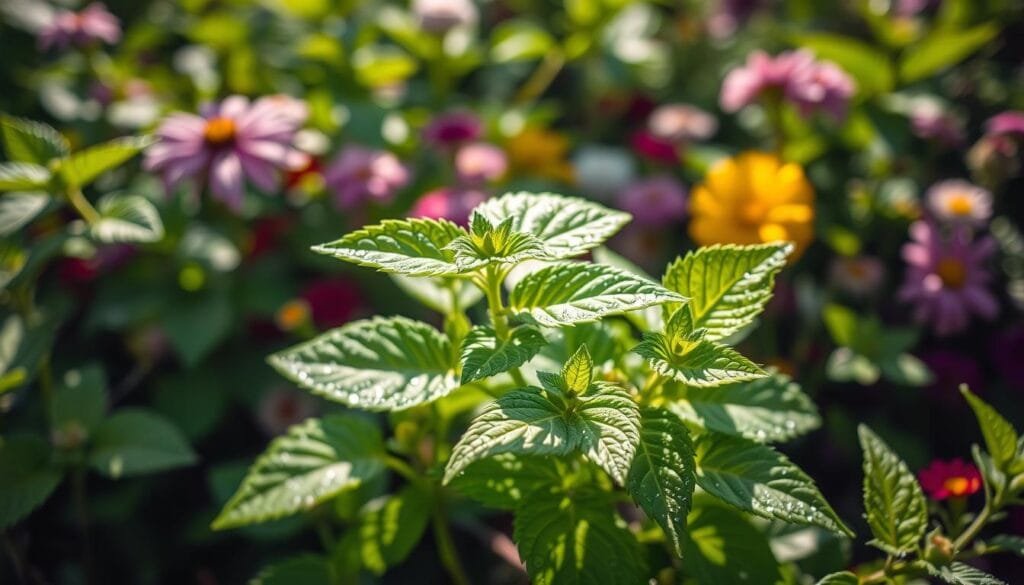
“Lemon balm has a 2000-year history, with documented use in various pharmacopoeias for treatment of anxiety, stress management, sleep disorders, cognitive enhancement, antiviral activity, and digestive health.”
Lemon balm is a remarkable herb for natural healthcare. It can help with stress, sleep, and cognitive function. This “nature’s calming agent” is worth considering.
Best Herbs for Respiratory Support
The garden is full of natural remedies for healthy lungs. There are herbs for coughs, decongestants, and expectorants. These can help with various respiratory issues. Let’s look at some top herbs for your healing garden.
Mullein is a great herb for the lungs. It grows well in sunny spots. Its leaves and stalks have been used for centuries to soothe airways and improve breathing.
Horehound is good for getting rid of mucus and easing spasms. It loves dry, sunny areas. It’s a key herb for lung health.
Wild cherry and chokecherry barks are great for dry coughs. They grow best in the wild. Marshmallow is another herb that loves moist places. It’s very good for moisturizing the lungs.
- Mullein: A respiratory tonic that grows in sunny, open, disturbed soil
- Horehound: Expels mucus and eases spasms, thrives in dry, sunny spots
- Wild Cherry & Chokecherry: Soothe dry, irritated coughs (best wildcrafted)
- Marshmallow: Moisturizing herb that prefers moist, meadow-like environments
Plantain is a common weed that’s great for the lungs. It helps with irritation and dryness. Other herbs like nettle, goldenrod, bee balm, oregano, and thyme also support the respiratory system.
“Herbal remedies for coughs and other respiratory issues can be easily grown in your own garden, providing a natural and sustainable way to support lung health.”
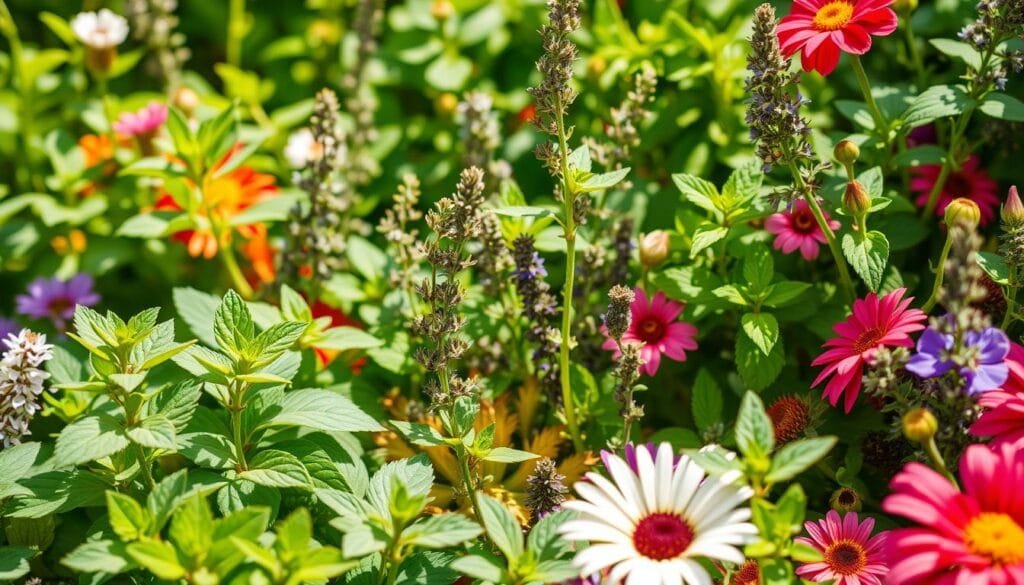
Adding these herbs to your garden can help you make natural remedies. You can make cough syrups or steam inhalations. These respiratory herbs offer endless ways to improve your health.
Creating a Year-Round Harvest Schedule
To have fresh herbs all year, plan your garden well. Use smart planting and harvesting. This way, you can have herbs ready to pick all year long.
Seasonal Planning Guide
Start by thinking about what each herb needs to grow. Some herbs, like cilantro, do best in cool spring. Others, like basil, love the summer heat. By planting different herbs, you can pick the best ones at the right time.
- For spring, choose cool-weather herbs like chives and parsley.
- In summer, enjoy warm-weather herbs like basil and oregano.
- Autumn is for heartier herbs like sage and mint.
Storage and Preservation Methods
After picking your herbs, it’s important to store them right. Dry them in a cool, dark spot or on a screen. To keep them longer, freeze them in water or olive oil. This makes it easy to use them in cooking later.
With good planning and storage, you can enjoy your homegrown herbs all year. This way, you’ll always have fresh flavors in your kitchen.
Common Growing Challenges and Solutions
Growing a medicinal herb garden is rewarding but comes with challenges. I’ve faced issues like pests and diseases. But, with the right knowledge, these problems can be solved.
Pest control is a big challenge. Aphids, spider mites, and rabbits can harm plants. Companion planting helps by attracting beneficial insects. Marigolds are great at keeping pests away.
Fungal diseases are another issue. To prevent them, ensure good drainage and air circulation. Plant herbs in well-draining soil and prune them regularly.
Keeping the right moisture level is key. Too much water can cause root rot, while too little can make plants wilt. Mulching with organic materials helps retain moisture and suppress weeds.
| Common Growing Challenges | Solutions |
|---|---|
| Pest Infestations | Companion Planting, Organic Pest Control |
| Fungal Diseases | Proper Drainage, Air Circulation, Pruning |
| Improper Watering | Mulching, Monitoring Soil Moisture |
By tackling these challenges, I’ve grown a thriving herb garden. It’s a reliable source of natural remedies. The effort is worth it for the rewards of growing your own healing herbs.
Sustainable Harvesting Practices for Medicinal Plants
I love gardening and using herbs for health. It’s key to harvest medicinal plants in a way that’s good for the planet. We need to protect our plant worlds because more people want natural health solutions. Using wildcrafting methods that are kind to nature helps keep these plants around for the future.
When I pick medicinal plants, I only take a third of what’s there. This lets the plant grow back. I use sharp, clean tools to avoid harming the plant or the soil. It’s also important to pick at the right time of day and season to get the most health benefits.
It’s also vital to not pick plants that are endangered. I learn about local plants that are safe to pick. I get permission to forage from landowners or authorities. Growing rare plants in my garden helps reduce the need to pick them from the wild.
